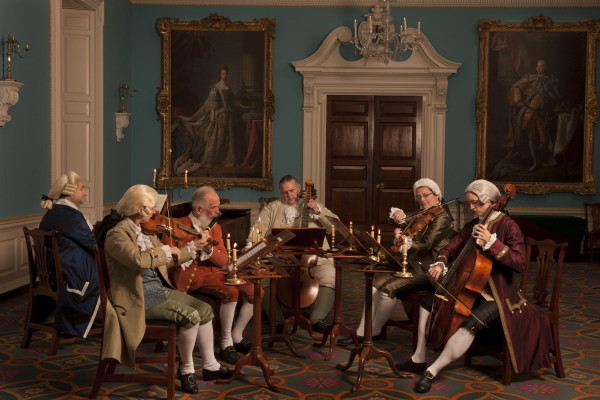
If you could put sound on a postcard, it might sound something like the Early Music Festival being held in Williamsburg next week. After all, our favorite postcards are typically idyllic scenes that capture passing moments. They transport us.
But the 18th century was a world of sound as much as sight. (And smells. But we’ll save that story for another day.) And while you might readily think of hammering in a trade shop, voices on the street, and the clopping of hooves as the quintessential noises of the colonial town, music was everywhere.
In 1771 the planter Landon Carter wrote, “I do suppose [new royal governor Lord Dunmore’s dogs] must make a great addition to the present modes of Concerts, for I hear from every house a constant tuting [tooting] may be listened to upon one instrument or another, whilst the Vocal dogs will no doubt compleat the howl.”
Apparently he wasn’t enamored of the musical abilities of the local folk. And yet, all manner of singing and instrument playing was heard.
The Early Music Festival promises much more polished performances and the opportunity to hear rarely played instruments, and to experience concerts in 18th century spaces. There are daytime programs, but four nights of evening entertainments at four different historic venues will be especially unique.
Colonial Virginians imported all sorts of music and instruments. A 1771 issue of Purdie and Dixon’s Virginia Gazette advertised musical instruments for sale, as well as sheet music for voice, harpsichord, violin, German flute, guitar, and hautboy. That last one was the quirky English spelling for the oboe.
The musicians are a combination of talented folks from Colonial Williamsburg and all over the East Coast. You’ll surely recognize some of the music, but the festival will also have its share of less well-known composers. Hey, even the 18th century had its share of one-hit wonders.
It kicks off on Tuesday, September 22 with a candlelit concert in the Governor’s Palace ballroom, where The Governor’s Musick, Colonial Williamsburg’s resident performing ensemble, will play antique instruments.
An ad for a concert at the Raleigh Tavern in 1771 said, “There will be music provided for such of the Ladies and Gentlemen as chuse to dance after the concert.” Dancing was a big deal in those days—that’s why musicians would sometimes dangle a promise of dancing in order to get people to come hear them play. Sit still and listen to us for a while, they seemed to be saying, and then you can hoof it all you like.
Wednesday’s dance at the House of Burgesses will replicate that kind of experience, beginning with a couple of tunes that mark the end of an imagined concert—and the beginning of the dance. Colonial Williamsburg’s dance ensembles will lead the way through almost a dozen different dances, from the minuet to husking dances.
On Thursday we move to the chapel at the Christopher Wren Building on William and Mary’s campus. Pomp and Ceremony: A Concert for Brass, Reeds, Organ, and Drums should have plenty of firepower, but it also has a couple of really interesting early instruments: baroque oboes and a baroque bassoon.
The festival’s grand finale on Friday features the largest costumed music event in Colonial Williamsburg’s history. It will occur at Bruton Parish in conjunction with the church’s 300th anniversary celebration. 16 musicians will play works by Vivaldi, Handel, and Mouret, as well as English composers William Boyce and Thomas Arne.
Thomas Jefferson (the famed violinist) wrote, “Music is invaluable where a person has an ear. It furnishes a delightful recreation for the hours of respite from the cares of the day, and lasts us through life.”
Much respite awaits next week. And what a privilege to be able to hear some new old sounds.
Leave a Reply